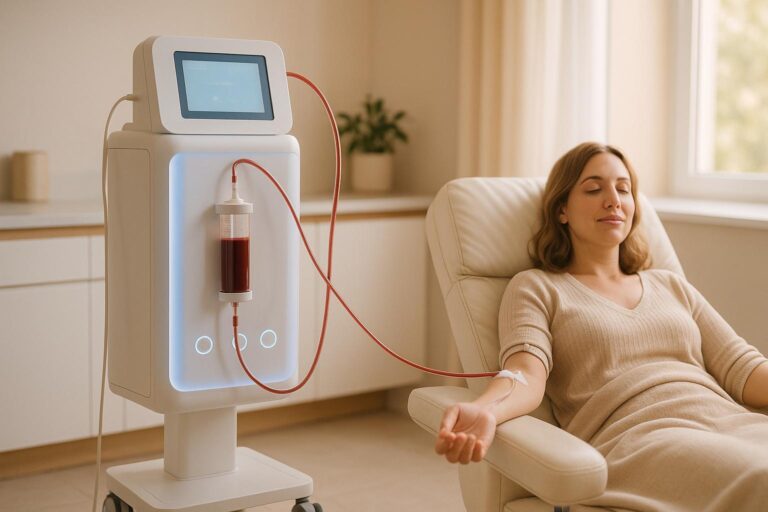IV therapy delivers nutrients, medications, or fluids directly into your bloodstream for faster and more targeted pain relief. It bypasses the digestive system, ensuring 100% absorption and quicker effects compared to oral treatments. This approach is gaining traction as a safer alternative to opioids for managing pain and inflammation.
Key takeaways from the article:
- IV Ketamine: Reduces chronic pain by blocking overactive pain receptors. Effective for conditions like fibromyalgia and migraines but requires close monitoring due to potential side effects.
- Ozone Therapy: Lowers inflammation by boosting antioxidant defenses. Particularly useful for herniated discs and musculoskeletal pain.
- Stem Cell Therapy: Repairs damaged tissues and reduces inflammation. Ideal for soft tissue injuries but comes with high costs ($5,000–$50,000+).
IV therapies are most effective when tailored to individual needs and combined with other treatments like physical therapy or lifestyle changes. While promising, they also carry risks like infections or vein damage, emphasizing the importance of professional oversight.
Quick Comparison
| Therapy Type | Mechanism | Best For | Key Risks | Cost Range |
|---|---|---|---|---|
| Ketamine | Blocks pain signals via NMDA | Chronic pain, migraines, CRPS | Dizziness, dissociation | $250–$800/session |
| Ozone Therapy | Reduces inflammation | Herniated discs, joint pain | Minimal, low complication rate | $250–$500/session |
| Stem Cells | Tissue repair & immune response | Soft tissue injuries, arthritis | High cost, variable outcomes | $5,000–$50,000+ |
IV therapy offers a promising route for pain management but requires careful consideration of costs, risks, and individual suitability.
How Ketamine Infusion Therapy Relieves Chronic Pain
Research-Backed IV Therapies for Pain Relief
The scientific community has gathered substantial evidence supporting various IV therapies for managing pain. Each therapy works through distinct biochemical pathways, offering different strategies to address pain and inflammation.
IV Ketamine for Chronic Pain
Originally developed as a dissociative anesthetic, ketamine has become a valuable option for chronic pain management by targeting NMDA receptors in the brain. Unlike opioids, ketamine is less likely to cause dependence or respiratory issues, making it a safer choice for long-term use.
Ketamine therapy typically involves IV infusions lasting anywhere from 40 minutes to several hours. Many patients report reduced pain for days or even weeks after just one session. It has shown particular effectiveness for conditions that are resistant to other treatments, such as neuropathic pain, complex regional pain syndrome (CRPS), fibromyalgia, migraines, and cancer-related pain.
A key 2014 study in the Journal of Pain Research highlighted ketamine’s ability to significantly relieve neuropathic pain in patients who had exhausted other treatment options. The study even found ketamine to be more effective than opioids for this type of pain.
"Until definite proof is obtained that the benefits of ketamine are greater than its risks, we argue that ketamine administration should be restricted to patients with severe and therapy-resistant neuropathic pain, such as in the case of refractory CRPS pain."
– Marieke Niesters, Department of Anesthesiology, Leiden University Medical Center
While ketamine offers promising results, potential side effects like dizziness, elevated blood pressure, and dissociation can occur. These effects are temporary and carefully monitored during treatment.
IV Ozone Therapy for Inflammation
Ozone therapy takes a unique approach to pain relief by modulating the immune system and balancing inflammatory responses. When ozone interacts with body fluids, it produces hydrogen peroxide and oxidized lipids, which activate the NRF2 pathway. This boosts the body’s antioxidant defenses and reduces inflammation.
Research backing ozone therapy is extensive. A 2010 meta-analysis found that ozone therapy for herniated discs achieved results comparable to surgical discectomy but with a much lower complication rate of just 0.064%. Systematic reviews consistently show ozone’s effectiveness over placebo treatments for various pain conditions.
In one 2004 study by Moretti et al., ozone therapy was compared to mesotherapy for patients with neck pain. The results were compelling: 78% of patients in the ozone group experienced optimal or good outcomes, compared to 56.25% in the mesotherapy group.
"When applying this therapy, we are really inducing a controlled and harmless ‘micro-oxidation’ that will produce a modulation of the cellular antioxidant system and the inflammation system."
– Francisco Javier Hidalgo-Tallón, Institute of Neurosciences, University of Granada, Spain
With a growing acceptance of this treatment, the ozone therapy market is projected to reach $4.5 billion by 2032. Clinical trials also indicate a safety profile similar to hyaluronic acid injections, with no severe adverse reactions reported.
Stem Cell IV Therapy in Regenerative Medicine
Unlike therapies that focus on symptom relief, stem cell IV therapy aims to repair damaged tissues, addressing the root cause of pain. When introduced into the bloodstream, stem cells distribute throughout the body, transforming into specialized cells needed for tissue healing.
Mesenchymal stem cells (MSCs) are particularly effective because they can repair damaged cartilage and are immunoprivileged, meaning they are less likely to trigger immune reactions. These cells work by releasing growth factors, reducing inflammation, and differentiating into various cell types like osteocytes and chondrocytes.
The results are impressive. A five-year study by Pascual-Garrido et al. showed that stem cell therapy improved clinical scores and reduced pain in seven out of eight patients with chronic patellar tendinopathy. The most significant improvements were observed at two years and maintained through five years.
What sets stem cell therapy apart is its anti-inflammatory and immunomodulatory abilities. MSCs suppress inflammatory cell development, limit T cell activity, and create a healing environment by producing collagen, anti-inflammatory cytokines, and analgesic proteins. For joint pain, these cells activate genes that enhance tissue repair and reduce inflammation.
This therapy addresses a critical need, as chronic pain affects 68% of adults over 60 worldwide. While traditional treatments often only manage symptoms, randomized controlled trials have shown stem cell therapy’s potential to tackle the underlying causes of pain.
However, patients should be aware of the financial commitment, as costs range from $5,000 to $50,000 or more. The minimally invasive nature of IV delivery makes it an appealing outpatient option compared to other methods.
How IV Therapies Address Pain and Inflammation
IV therapies work by targeting specific cellular pathways to alleviate pain and reduce inflammation. Let’s break down how ketamine, ozone, and stem cells play a role in managing these conditions.
How Ketamine Blocks Pain Signals
Ketamine helps manage pain by blocking N-methyl-D-aspartate (NMDA) receptors in the brain and spinal cord, which are responsible for transmitting pain signals. In cases of chronic pain, these receptors often become overactive, amplifying the sensation of pain. By inhibiting their activity, ketamine disrupts this pain signaling loop.
In addition to blocking pain signals, ketamine influences gene expression pathways that are linked to chronic pain. It reduces NMDA receptor activity, limits the activation of astrocytes and microglia – immune cells that can worsen pain when overstimulated – and improves synaptic function. Its anti-inflammatory properties further help by reducing inflammation that often accompanies chronic pain. Studies have shown that ketamine reduces pain levels at concentrations around 200 ng/ml, which aligns with the doses used for therapeutic purposes.
However, ketamine’s powerful effects require careful consideration. It’s not suitable for everyone, particularly individuals with a history of schizophrenia, bipolar disorder, or substance abuse. This careful selection process ensures its safe and effective use for rapid pain relief.
Ozone Therapy’s Role in Reducing Inflammation
Ozone therapy helps manage pain and inflammation by inducing controlled oxidative stress, which strengthens the body’s natural defenses. When ozone interacts with interstitial fluids, it creates compounds that activate the NRF2 pathway. This leads to enhanced antioxidant defenses and reduced activity in pain receptors.
Administered within a specific "therapeutic window" – between 10 to 80 μg/ml of ozone per ml of blood – ozone therapy has shown promising effects. For joint-related conditions, ozone therapy works by inactivating harmful enzymes and promoting the growth of fibroblasts and chondrocytes, which are essential for cartilage repair. It also improves blood flow and oxygen delivery to tissues, contributing to an overall sense of relief and well-being. This multi-layered approach highlights ozone’s ability to address both pain and inflammation effectively.
Stem Cells: Regeneration and Immune Response
Stem cell IV therapy tackles pain by encouraging tissue repair and modulating the immune system. Once administered, mesenchymal stem cells (MSCs) migrate to inflamed areas, guided by chemotactic signals. These cells have the unique ability to "sense" the level of inflammation in their surroundings and respond by releasing growth factors and cytokines to actively reduce the inflammatory process.
"MSCs can provide the right biochemical cues depending on how they sense the wound bed micro-environmental signals. This individualized approach could help reduce inflammation and, therefore, tissue repair with its expected high scar tissue levels."
- William J. Ennis, DO, MBA, Professor of Clinical Surgery and Chief of the Section of Wound Healing and Tissue Repair
The therapeutic power of MSCs lies in their paracrine function – where they release bioactive molecules that support healing rather than directly transforming into new tissue. These secretions promote blood vessel formation (angiogenesis), suppress cytokine production, and create a favorable environment for natural healing.
Studies back up these benefits. For instance, Dash et al. found that MSC injections improved wound healing and reduced pain in ischemic and diabetic ulcers. They observed increased vascularity and the presence of immature cells and reticulin fibers, which were absent in untreated cases. Similarly, Wu et al. demonstrated that MSCs promoted angiogenesis and differentiated into epidermal cells in diabetic mouse models.
MSCs also have the ability to differentiate into various tissue types – like bone cells (osteocytes) and cartilage cells (chondrocytes) – allowing them to replace damaged cells directly. At the same time, they release factors that enhance the healing process. This combination of tissue repair and immune modulation makes stem cell therapy a powerful tool for managing chronic pain and inflammation.
sbb-itb-d9e542d
Clinical Outcomes and Safety of IV Therapy
Clinical studies have confirmed that IV therapies can provide meaningful pain relief, though each type comes with its own safety considerations.
Effectiveness in Pain Reduction
Research continues to validate the effectiveness of IV therapies in reducing pain. For example, clinical trials have shown that ketamine infusions significantly lower pain scores. Similarly, ozone therapy and IV stem cell treatments have demonstrated measurable improvements in both pain levels and mobility.
Ozone therapy, in particular, has been shown to outperform placebo treatments. A systematic review involving 428 patients across multiple randomized controlled trials highlighted that ozone injections could significantly reduce pain and enhance mobility, especially for individuals with herniated disks.
IV stem cell therapy works by promoting tissue regeneration, making it particularly effective for soft tissue injuries like rotator cuff tears and ligament damage. However, its impact on conditions such as osteoarthritis tends to be less pronounced. Beyond pain relief, stem cell treatments can also reduce inflammation and improve joint function.
In an innovative approach, Pain and Emotion Therapy, administered through IV-supported protocols, showed promising results. In a randomized controlled trial with 89 chronic pain patients, participants reported a 10-point reduction on a 100-point pain intensity scale over six months. Professor Sylvia Gustin explained:
"By changing how we manage emotions, it is possible to change the experience of pain itself. This is not just a temporary relief but a potential long-term improvement in quality of life for those affected by chronic pain."
Safety Profiles and Potential Risks
While IV therapies offer substantial benefits, they are not without risks. Complications such as infections, vein damage, allergic reactions, clotting, and medication leakage can occur. These issues may lead to IV failures in up to 53% of cases, resulting in extended hospital stays, higher costs, and even increased mortality rates.
Ozone therapy, however, has an impressively low complication rate – just 0.064% in treating herniated disks – with side effects similar to those observed in control groups. IV stem cell therapy is also generally well tolerated, though outcomes can vary depending on the condition being treated and the specific regimen used.
To minimize risks, strict safety protocols are essential. These include sterile techniques, continuous patient monitoring, and ensuring that treatments are administered by qualified professionals. As emphasized by Nouveau MedSpas:
"Because IV therapies involve direct access to the bloodstream, any contamination or error in administration can have immediate and serious consequences. Therefore, maintaining the highest safety standards is crucial."
Comparison of IV Therapies
The clinical outcomes and safety data provide a basis for comparing different IV therapies:
| Therapy Type | Primary Mechanism | Effectiveness | Safety Profile | Best For | Key Considerations |
|---|---|---|---|---|---|
| Ketamine | NMDA receptor antagonism | 26% of patients report a 50% improvement after 6 weeks | Requires close monitoring | Chronic pain and depression-related conditions | Infusion frequency decreases over time |
| Ozone | Anti-inflammatory effects | Outperforms placebo and matches other treatments | Very low complication rate (0.064%) | Herniated disks and musculoskeletal conditions | Accurate dosing is critical |
| Stem Cells | Tissue regeneration and immune modulation | More effective for soft tissue injuries than osteoarthritis | Generally well tolerated | Soft tissue injuries and regenerative needs | May require multiple sessions |
Each therapy has its strengths, and the best choice depends on the patient’s condition, overall health, and treatment objectives. Ketamine infusions can provide rapid relief for severe, treatment-resistant pain. Ozone therapy offers consistent results with minimal risks, while stem cell treatments support long-term healing through tissue regeneration.
These findings form the foundation of Kinnection Clinic’s IV therapy programs, which integrate functional and regenerative techniques to deliver lasting pain relief.
Integrating IV Therapy into Complete Pain Management
IV therapy becomes even more effective when it’s part of a broader, well-rounded approach to pain management. Instead of focusing solely on symptoms, a functional and regenerative medicine strategy aims to address the underlying causes of pain and inflammation. Chronic pain is a widespread issue, impacting roughly 100 million Americans, with the prevalence of painful conditions rising from 32.9% in 1998 to 41.0% by 2014.
This holistic understanding underscores the value of blending IV therapy with other treatments to achieve long-term relief.
Personalized Treatment Plans for Lasting Results
The effectiveness of IV therapy increases significantly when treatments are tailored to each person’s unique needs. Custom IV formulations are designed to address individual nutritional deficiencies, stress levels, and chronic conditions. This is particularly important given that around 10% of Americans lack adequate levels of essential nutrients like iron and vitamins C, D, B6, and B12.
Comprehensive lab tests identify specific nutrient deficiencies, enabling the creation of targeted IV solutions. These often include anti-inflammatory components like Vitamin C, Glutathione, Magnesium, B Vitamins, and Trace Minerals.
At Kinnection Clinic, IV therapy is integrated with Gonstead chiropractic care to enhance spinal alignment and overall wellness. By focusing on the root causes of health issues, IV therapy becomes a key element in a larger, personalized wellness strategy.
This targeted approach not only improves clinical outcomes but also delivers nutrients and medications directly into the bloodstream. By bypassing the digestive system, IV therapy ensures faster absorption, quicker therapeutic effects, and better recovery for those dealing with chronic pain.
Complementary Therapies for Optimal Outcomes
Pairing IV therapy with complementary treatments can significantly enhance pain relief. Regenerative medicine, which focuses on repairing damaged tissues and restoring function, works seamlessly alongside IV therapy to address pain at multiple levels.
For example, combining IV therapy with Gonstead chiropractic care tackles both inflammation and structural alignment issues, offering a more comprehensive and lasting solution. While IV therapy reduces cellular inflammation, healthy lifestyle changes help maintain these benefits.
Lifestyle adjustments such as adopting an anti-inflammatory diet, managing stress, engaging in moderate exercise, and ensuring quality sleep can amplify the positive effects of IV therapy. Moderate physical activities like walking, swimming, or cycling improve circulation and support nutrient delivery from IV treatments. Meanwhile, quality sleep allows the body to repair tissues and regulate inflammation, which is crucial for managing pain.
As Reagan Integrated Sports Medicine highlights:
"Combined with a personalized program of IV therapy, the following elements of a healthy lifestyle will work wonders for your mood, endurance, energy, and recovery."
Additionally, IV therapy can complement other treatments like physical therapy, medication management, and mind-body techniques. It offers a natural, non-invasive alternative to opioids, NSAIDs, or steroid injections, without the risks of addiction or severe side effects.
Conclusion
Drawing on findings from a range of studies, IV therapy emerges as a complex but potentially effective option for pain management, with outcomes heavily influenced by the type of treatment and individual patient factors.
For example, research highlights that IV ketamine can provide short-term relief for chronic non-cancer pain. However, other therapies still require more robust validation to establish their effectiveness. One clear advantage of IV therapy is its ability to bypass the digestive system, allowing for immediate absorption of nutrients and electrolytes. This rapid delivery can be particularly helpful in managing chronic inflammation.
The financial and emotional burden of chronic pain in the U.S. – costing billions annually – underscores the urgency of finding effective solutions. Some studies point to measurable benefits. A 2009 study involving 34 adults with fibromyalgia showed significant improvements in pain levels, mood, and overall quality of life after eight weeks of Myers’ cocktail IV therapy. Moreover, up to 70% of patients undergoing IV infusion therapy report noticeable symptom relief.
However, it’s essential to approach IV therapy with caution. Dr. Brent A. Bauer of the Mayo Clinic warns about potential risks, even with natural substances like vitamins and minerals:
"Anything we place in the human body can carry risk, including those things which are thought to be natural, such as vitamins or fluids. High doses of certain vitamins and minerals have been linked to kidney damage, heart rhythm abnormalities, blood pressure changes, gastrointestinal symptoms and damage of the peripheral nerves."
Ultimately, IV therapy appears most effective when integrated into a personalized, research-driven care plan. At Kinnection Clinic, this approach focuses on addressing the root causes of pain rather than merely treating symptoms. With proper medical oversight and tailored treatment strategies, IV therapy offers a pathway to meaningful, long-term relief for many individuals battling chronic pain.
That said, the cost – ranging from $250 to $800 per session – is an important consideration when weighing the potential benefits against the risks.
FAQs
What are the possible side effects and risks of IV ketamine therapy for pain relief?
IV ketamine therapy is usually well-tolerated, but like any medical treatment, it can come with side effects. Common ones include nausea, dizziness, vivid dreams or hallucinations, blurred vision, and mild discomfort at the injection site. Some people may also notice impaired motor skills or a feeling of vertigo either during or shortly after the session.
Though less common, more serious risks can occur, such as elevated blood pressure, psychiatric reactions, or, in rare instances, allergic responses and cardiovascular issues. To ensure the therapy is right for you, it’s essential to share your medical history with your provider.
During your infusion, the care team will monitor you closely to reduce risks and quickly address any side effects, keeping your safety and comfort as their top priority.
How does ozone therapy compare to surgery for treating herniated discs?
Ozone therapy is a less invasive option for treating herniated discs, offering a compelling alternative to surgery. Research indicates success rates of about 88%, which often align with the outcomes of surgical procedures. Instead of requiring a major operation, this therapy uses outpatient injections to shrink the affected disc and alleviate nerve pressure, all while minimizing risks, recovery time, and downtime.
Beyond its immediate benefits, ozone therapy has shown to provide lasting relief, with effects that can extend for up to 10 years. For individuals looking for effective pain management and quicker recovery, this treatment presents an option worth exploring.
What should I consider before investing in stem cell IV therapy for soft tissue injuries?
When considering stem cell IV therapy for soft tissue injuries, there are a few key points to keep in mind. Start by assessing the severity and location of your injury, as well as your overall health. Weigh the potential benefits against any risks, and don’t overlook the cost, which typically falls between $5,000 and $50,000. Staying informed by reviewing the latest research on the therapy’s effectiveness can also help you make a more confident decision.
For a more tailored approach, consulting with a specialist – like the team at Kinnection Clinic – can offer valuable insights. They can help you determine whether this treatment aligns with your recovery needs and overall health goals.



